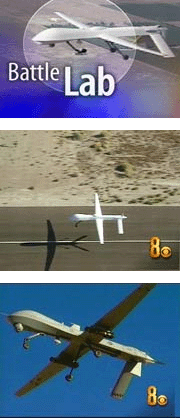Predator UAV 'Battle Lab' Just North of Las Vegas
By George Knapp, Investigative Reporter | klas-tv.com
 The next time you take a swat at a pesky flying insect, you might want to take a closer look. A new generation of bug-sized robots is being developed by the military, and soon enough they will be in the private sector too. The next time you take a swat at a pesky flying insect, you might want to take a closer look. A new generation of bug-sized robots is being developed by the military, and soon enough they will be in the private sector too.
Part of the impetus for this cutting edge research is the success of the Predator UAV, or unmanned aerial vehicle. Predator is based at what's called a "Battle Lab" at the Indian Springs air base north of town. The I-Team found out that all sorts of high-tech gizmos are already in the works out there.
When Col. Larry Felder worked at the Pentagon back in the 90s, he was part of an elite team that forecast the potential of UAV's -- unmanned aerial vehicles. The team also created the concept of battle labs, that is, specialized think tanks that focus on particular military needs. Little did Felder know that years later, he would be the commander of a battle lab, in fact, the UAV battle lab at Indian Springs, which is the nerve center of a cutting edge technology that is exploding in many directions.
Indian Springs is the home of the best-known UAV -- the Predator. It was Felder's team that came up with the idea of arming Predators with missiles. Other innovations allow operators based at Nellis to fly via satellite, Predators in Iraq and Afghanistan and to daily take out the enemy. But this is only the beginning for UAVs.
Col. Larry Felder, USAF Battle Lab Commander, says, "UAVs will not replace manned aircraft. There are missions they can't do. But what they're good at is what I call the dull dirty and dangerous."
For example, UAVs can now be linked to robots on the ground. Those robots can be sent into dangerous areas instead of sending troops. In the air, a new generation of Predator is on the way, bigger, more powerful.
Col. Felder says the Air Force is also developing an unmanned combat robot as big as a stealth, and eventually, entire fleets of intelligent stealthy UAVs will take to the skies, talk to each other, and coordinate their attacks, no pilots required. Bigger UAVs are interesting, but it's the tiny ones that will blow your mind.
Felder said, "There's a whole family of small UAVs evolving at DARPA and the labs. They're exploring very tiny, extremely tiny insect sized and some of those tiny contraptions might already be flying in Nevada.
Citizen watchdog Chuck Clark thinks the security around the Area 51 military base has heightened recently because of robo-bugs. "... flies close to the ground, the size of a model airplane, maybe even insect sized."
According to published reports, one micro bot in development will imitate the flying motion of dragonflies. NASA has said that its working on UAVs that are not only the same size as bees, but will even fly and navigate just like bees. Such robo gadgets could be used to explore the harsh surface of Mars, or other worlds, and perform maintenance duties on the exteriors of space ships during long missions. Closer to home, UAVs could eventually be used to patrol our borders or for homeland security.
"What they provide is persistence. They have the capability to stare for a long time. Over one frigging building to take one guy out or to follow to a nest, or on a coastline, what's coming in, what's going out," Col. Felder explained.
You've got to figure that law enforcement agencies will want their own UAVs at some point for criminal surveillance. And there will be commercial uses too. Already in Japan, something like the Predator has been adapted to work as a crop duster.
The sky, literally, is the limit. Of course, the battle lab is focused only on military applications and there is no shortage of ideas. Felder says, "We have thirteen initiatives, eleven are unclassified, two are in the classified realm.
A gigantic new hangar and headquarters is being built at Indian Springs, a structure big enough to accommodate a new generation of much larger UAVs, not to mention the smaller ones. Since the Air Force is putting millions of dollars into the project, it looks like UAVs are in Indian Springs to stay.
Article from: http://www.klas-tv.com/global/story.asp?s=3001647&ClientType=Printable

|
